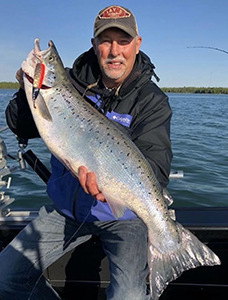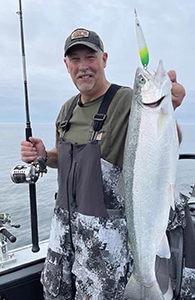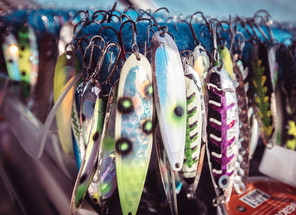Posted by Chris Larsen on 11th Apr 2023
The Best Spoons For Trolling Salmon, Trout, and Walleye
Spoons may be the most versatile trolling lure on the market today. You can catch just about anything in nearly any situation on a spoon. Mark Romanack from Fishing 411TV joined the Great Lakes Fishing Podcast to discuss the best trolling spoons and how he chooses spoons. You can listen to the entire conversation by clicking here.
What is the best spoon for trolling?
Finding the best spoon for trolling for salmon, trout, and walleye isn’t easy. Romanack says spoons have come a long way since their beginnings. “There are different kinds of spoons for different applications, and even the early trolling spoons weren't all that productive at trolling because back then folks just simply didn't understand what it took to make a good trolling spoon. The first spoons people think of are things like the Eppinger Daredevle. I mean, it's been around forever. It's a tremendous spoon. But that is definitely a casting spoon. It is not a trolling spoon. It's just too heavy to have good action at the speeds that we would normally troll at, and so the first thing you have to be looking at is trolling spoons are typically going to be thinner. That's a good thing and it's a bad thing. The good thing is that a thin spoon has a lot of action at relatively slow speeds so they can troll slow, moderate speeds, and even fast speeds. The downside is that they're easily bent, and so if you get a big kahuna tuna on there and you're struggling with this big salmon, by the time you get it in the boat, there's a pretty good chance that fish has destroyed your spoon and once they're bent you can't bend them back and get them to do what they're supposed to do. It just doesn't work that way, and so a spoon doesn't last forever. In other words, I'm replacing spoons every single year. It's just a matter of the game that you're playing and some species of fish are worse than others. In my opinion, the coho is the one that kills a lot of our spoons because as you know they roll a lot and when they roll and twist, that's what damages the spoon, and they do it not only in the water but as soon as they hit the landing net, they're doing it even more.”

How do you know if a spoon has had enough? Mark says you’ll know it when you see it. “You could pretty well tell if you look at it and it's tweaked. I'm not talking about just scratches on the finishing stuff from the teeth, but if you look at it and you can see that it's bent. As an easy litmus test, take two spoons, lay one on top of another, and if they don't mesh perfectly, you know with a spoon, you know is true, then the spoon is tweaked and it's no good anymore. I just toss them in a pile and that pile just gets bigger and bigger.”
“Some spoons are more notorious for bending than others, the larger the spoon is, the more surface area it is the more likely it's going to bend. Smaller spoons tend to be used for smaller species that are less aggressive, and they don't tend to bend so much. Like, for example, the little Junior Streaks that we use for walleye, I almost never bend one of those. But the standards and the magnums that we use for trout and salmon, get bent constantly. So, it's just part of the game.”
What is the best size spoon to use? Romanack says it depends on the situation. “ It comes down to what you're trying to imitate, what forage is out there that you're trying to imitate, and that'll of course have a big factor on what type of fish that you're trying to target. If you're going after salmon, there's a pretty good chance that you're going to be using the larger-size spoons. They're typically called magnums or the standardized spoons because those are the size that does a really good job of imitating the thing a salmon is likely to eat, like alewives or gizzard shad.”
If you’re trolling for walleyes, Mark says scaling down is typically the right play. “Walleye are eating different forage. A walleye is more likely to be eating something like an emerald shiner, which is a smaller and more slender bait fish. You want a slender spoon to replicate that the best as possible, and there are medium-sized spoons. I use a lot of Silver Streaks and… the smallest one that's called a Junior Streak. The only thing I use that for is walleye fishing. I know some guys use them for some other applications, but that's my go-to walleye spoon.”
The term “match the hatch” is commonly heard among anglers and it applies to trolling spoons as well. Romanack says he puts his spoons in target-rich water and tries to match his lures with the predominant forage. “Typically, when we're targeting trout and salmon, we're looking for a specific water temperature that we know they're going to be abundant in and that typically runs from 50 to about 60 degrees. For example, I was steelhead fishing recently. The coolest water we could find was 60 degrees and that's where the steelhead were. The spoon size is not as relevant as what the available forage is going to be. If you're using a big spoon like a magnum but those fish have been keyed on feeding on smaller smelt, maybe a three-inch smelt, your spoon is not going to look natural to them because they're not used to forage that big and they're going to abandon that spoon.”
Most people think of spoons as tools for faster trolling. When it comes to trolling speed, Romanack says it depends on the temperature of the water and the species you’re chasing. “When it's really cold water, we're naturally going to slow down because those fish are going to be a little bit more lethargic in cold water than they would be in warm water. But the exception to that rule is trout and salmon, even in cold water, salmon will chase baits at a relatively high rate of speed. 2.2 to 2.5 miles an hour is not uncommon even when the water's only 42 to 45 degrees. So, in that situation, you're dealing with something that's a little bit different dichotomy. Those fish will chase even in cold water. But other species of fish, like say, for example, a walleye. Walleye is a warm water species. They typically are not interested in spoons until you get to the point where you can troll about two miles an hour, and for me, that water temperature is about 60 degrees. So, when that water temperature gets to about 60 degrees, I start thinking of spoons because now I know I can go fast enough to give the spoon great action. The problem with a lot of spoons is if you get below two miles an hour, you're going to lose a lot of action on those spoons. So, most spoons come to life at 2 to 2.5. That's where they're the best. If you dip down to 1.8 or 1.9, you might have action or you might not, and it depends on the spoon. It also depends on whether you're trolling into the sea or whether you're trolling with a following sea. There's a lot to understanding about how to get the most out of spoons. In general, I would say a spoon is a presentation that shines better at higher speeds.”
“You don't have to fish a spoon clean, you can fish it with an attractor. There's a variety of them out there that guys can use. The one that I've fallen on that I seem to like the best is a product made by Yakima Bait. It's called a Spin Fish. It's a triangular shape, and they're very popular in the Pacific Northwest. You don't see a lot of guys here using them in the Great Lakes yet. But it's triangular in shape, and the reason I like it is because it doesn't create any drag or resistance. A typical attractor like a rotator is going around and round in the water, creating a fair amount of resistance whereas a spin fish is just spinning on its axis, and so the beauty of it is it puts out more flash. So, I'll rig a Spin Fish on the line and then I'll rig my spoon directly behind it about six feet away. So, you get a Spin Fish that's creating flash, and then you've got your spoon trailing that. I'll take that whole rig and I'll set it behind a downrigger 20 to 50 feet down, depending on the clarity of the water, and that has been lights out for me. I can't tell you how many walleye that steelhead, cohos, king salmon, and brown trout, we've caught doing that. So, that extra flash brings those fish into the gear, and then once they get into the gear and get close, then, of course, they see the spoon it’s game on.”
What is the best trolling spoon color?
“I look at color as important. I mean, we all know that certain colors work better on certain days, depending on the water clarity, light penetration, and all those variables. But the fact is, I believe we put way too much emphasis on color and not nearly enough emphasis on presentation and whether it's the spoon or whatever lure is doing what it's supposed to be doing that's stated. We have biases and I'm just as guilty as the next guy. I've got my biases of colors that I like. When it comes to trout and salmon. Particularly king salmon and coho salmon I'm going to pick spoons that have green, blue, and chartreuse on them. They're going to have silverbacks every single time. I don't use a gold back or a copper back spoon. When I'm salmon fishing, I want silver. I'm trying to replicate the flash of a tail wipe. That’s basically what I'm trying to do.”

Mark says the color spectrum for walleye spoons is very different. “Walleye spoons are the craziest colors you've ever seen. I mean, I've got ones with pink backs, chartreuse back ones that have, well, what I would call an antifreeze back. They stand out because that spoon stands out against the crowd. Guess what? The fish see it and they attack it.”
For steelhead, Mark believes anything with orange is the ticket. “You can use any color you want for steelhead, as long as it's got some orange on that spoon. I’m a really big advocate of orange when it comes to steelhead fishing. The whole spoon doesn't have to be orange. It can be just a tip of orange or just a little piece of orange on it. But a silver back spoon with some orange on the face is going to catch steelhead day in and day out.”
Of course, spoons not only have different colors, but they also have different patterns of colors. Romanack looks for contrasting patterns when he’s choosing spoons. “I'll tend to choose a spoon that's got some glow in the dark on it. I don't like spoons that are too glow-in-the-dark. I think that's overbearing and repels fish. But if you have a little strip that's glow in the dark on an otherwise spoon, that's not glowing, that can be very, very effective. So if you were fishing early in the day or late in the day, and you are using a glow spoon that's going to get a little bit more visibility of deep water I think that's a huge advantage. So, that's a good way you can do that. But mostly I look at it as contrast, and what I'm talking about is I want the different colors on the spoon to be highly contrasting to one another so that each compliments the other. I don't want similar colors side by side because they blend in together. If you have orange down one side, and a darker color like black or purple on the other side, they're going to be very contrasting to one another, and to me that makes the spoon more easily seen.”
I think leaders and the diameter, of the leaders that we use can make a big difference. The thing that I think a lot of us don't realize is how a leader impacts your action. Now if you're a salmon guy and you're fishing lead cores or even maybe on your downrigger rods and stuff, you're probably having a minimum of a 20-pound test line, and that's fine if you're trolling with a magnum spoon or a standard spoon you're probably going to do just fine with 20-pound test. But what happens if you're going to chase brown trout or maybe walleye and you're going to run that mini-size or those smaller spoons like the Junior Streaks? If you're running 20-pound test on them, you're not getting the action out of the spoon, you could get. So it's probably going to cost you. So, people are thinking, oh God, Mark's going to tell me I got to redo my leaders on all of my lead cores every single time I go back and forth. We don't do that. I put a 20-pound leader on all of my lead cores, all of my coppers, and all of my weighted steel lines. So if I want to run a lighter leader, what I'll run is just a six-foot leader, a lighter material typically for brown trout for coho while I'm using smaller spoons. I drop down to 15-pound test. A six-foot 15-pound test leader is perfect to get that spoon lively. It makes a huge, huge difference.”
You can watch the entire interview by clicking on the player below.

